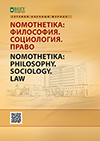Visual perception of art as the first step in the knowledge of the cultural and ideological basis of civilization
DOI:
https://doi.org/10.18413/2712-746X-2020-45-2-289-298Keywords:
culture, civilization, art, religion, Orthodoxy, history, temple, icon, calendar, image, symbol, RussiaAbstract
The problems of careful attitude to the visual and artistic images of traditional culture, which are inseparable from the spiritual foundations of the formation of cultural and civilizational space, are actualized. It is shown how a person in the cultural and civilizational space connects with the surrounding objects of material culture not only by the principle of determining their utilitarian qualities, but also in a natural sense of harmony and beauty of the surrounding world, which expresses the spiritual ideals of culture. They are a factor in the expression and formation of the worldview foundations of a person belonging to it, which directly affect the provisions adopted for guidance in his life, his beliefs: social, political, religious, etc. This factor is historically inherent in the process of cultural identification of a person and is inherent in any civilization.
Downloads
References
Борзова Е.П. 2002. История мировой культуры. СПб, Лань: 672 с.
Бургуэн Ж. 2006. Календарь. История и современность. М., Астрель; АСТ. 144 с.
Буркхардт Т. 2009. Искусство ислама. Язык и значение. Таганрог, Ирби: 288 с.
Губарева О.В. 2006. Божия Матерь в Ее иконах. Опыт художественно-богословского анализа. М., Паломник: 160 с.
Емохонова Л.Г. 2007. Художественная культура буддизма. М., Издательский центр «Академия»: 96 с.
Кузнецов В.П. 1997. История развития формы креста. Краткий курс православной ставрографии. М., Альманах «Жизнь вечная»: 40 с.
Кин М. 2006. Религии мира. Харьков, «Клуб семейного Досуга»: 240 с.
Любимов Л.Д. 1976. Искусство Западной Европы. Средние века. Возрождение в Италии. М., Просвещение: 320 с.
Новоселов М.А. 2004. Догмат и мистика в Православии, Католичестве, Протестантстве. М., Лепта-Пресс: 384 с.
Переслегин С.Б. 2005. Самоучитель игры на мировой шахматной доске. М., АСТ; СПб, Terra Fantastica: 619 с.
Самсонова Е.М., Ковальчук М.А. 2017. Индийская скульптура: от архаики до средневековья (XXII в. до н. э. – XVII в. н. э.). Хабаровск, Изд-во Тихоокеан. гос. ун-та: 200 с.
Спекторский Е.В. 2013. Христианство и культура. М., Центр стратегической конъюнктуры: 360 с.
Трубецкой Е. 1993. Умозрение в красках. Вопрос о смысле жизни в древнерусской религиозной живописи. В кн.: Философия русского религиозного искусства XVI–XX вв. Антология. Сост., общ. ред. и предисл. Н.К. Гаврюшина. М., Прогресс: 195–219.
Цеханская К.В. 2013. Почитание православных святынь в России. М., Паломник: 400 с.
Abstract views: 690
Share
Published
How to Cite
Issue
Section
Copyright (c) 2020 NOMOTHETIKA: Philosophy. Sociology. Law

This work is licensed under a Creative Commons Attribution 4.0 International License.


